Abstract
The present article focuses on pressed biofuel preparation from invasive herbaceous plants, and the quality indicators and properties were analyzed and determined. Two invasive herbaceous plants were chosen for this research: giant knotweed (Fallopia sachalinensis) and Sosnowsky’s hogweed (Heracleum sosnowskyi). For a control, pine wood biomass was utilized. After harvesting and drying, plant biomass was chopped and milled and later pressed into cylindrical pellets and briquettes. The research results for the pellets’ and briquettes’ physical and elemental properties showed that the density of the pellets (moisture 5–8%) reached 1145.60–1227.47 kg m−3, and the average density of the briquettes reached 615.60–867.31 kg m−3. The determined critical compressive strength of the pellets ranged from 420 N to 676 N, and the briquettes disintegrated under a significantly greater critical force of 783 N to 1219 N. The variation in pellet compressive strength with changes in their moisture content was also investigated. The determined lower caloric value of the pellets varied from 15.9 MJ kg−1 to 18.6 MJ kg−1. Harmful gas emissions during burning of the tested biofuel pellets were also evaluated and determined, and they were sufficiently low and did not exceed the permissible values. Finally, it can be stated that all of the pressed biofuels produced from invasive herbaceous plants met the most important requirements for the quality of pressed solid biofuel and can be used for burning in special boilers.
1. Introduction
Recently, increasing attention has been paid in the field of agricultural science to the use of biomass from new energy plants using sustainable energy. Biomass is classified as one of the main sources of renewable energy. Compared to solid fossil fuels, the use of plant-based biofuel significantly reduces the “greenhouse” effect; its CO2 emissions are approximately zero since the amount of CO2 released during combustion is used to produce organic matter during photosynthesis [,].
The rapid spread of invasive plants poses an increasing threat to natural ecosystems in all countries worldwide. As a result, several management strategies have been developed. Among them, mechanical (e.g., hoeing and digging) and chemical (e.g., herbicides) control methods are commonly used. Although these methods are effective, they are often very capital and human resource intensive, and there is no reversible energy cycle. In addition, the use of herbicides or other chemical control agents may cause unintended risks to native species and public health. Therefore, it is very important to develop innovative and economical strategies for the control of invasive plants [].
The widespread invasive plants in Lithuania include Sosnowsky’s hogweed and giant knotweed. These plants accumulate substantial biomass: Sosnowsky’s hogweed produces 10–15 t ha−1, while giant knotweed produces 8–14 t ha−1, which can be used as biofuel after being chopped, dried, and compressed. Use of this biomass would potentially pay for technologies to eradicate these invasive herbaceous plants. In addition, invasive herbaceous plants do not need to be sown, fertilized, or maintained, so their cultivation costs are zero. For this reason, their stored energy in the form of biomass should offset the costs of harvesting and preparation for burning [].
Heracleum sosnowskyi, a perennial herbaceous, monocarpic, and seed-propagated member of the Heracleum genus, is also known as Sosnowsky’s hogweed (family Apiaceae, synonym Umbelliferae). The plant’s competitive abilities, which are essential for successful dissemination, are increased by seed productivity that is regarded as high (10,000–20,000 seeds per plant) and germination percentages of up to 90% in the first year []. The presence of the highly toxic furanocoumarin in the plant’s sap poses a major concern to the human population due to its photoallergic qualities. Large blisters and burn symptoms could appear after contact with the plant and exposure to the sun [].
Giant knotweed (Fallopia sachalinensis), which originated for Eastern Asia, can reach heights of 1.5 to more than 3.5 m. The perennial plant known as knotweed emerges every year from a woody foundation []. About 15 t ha−1 d.b. (dry basis) of high productivity may be achieved by these plants. There are numerous types of knotweed, including Himalayan knotweed (Persicaria wallichii), giant knotweed (Fallopia sachalinensis), Bohemian knotweed (Fallopia bohemica), and Japanese knotweed (Fallopia japonica) [].
European countries have specific standards for regulating the quality of produced solid biofuel. In Sweden, the standard regulating the quality of pellets is SS187120, and in Germany, the standard DIN 51731 is valid, which also defines the requirements for pellets. In Europe, there is a wood pellet certification system called “ENplus”, which uses CEN/TC, EN, and ISO standards for solid pellet biofuel [].
The emissions limit values for fuel-burning devices are regulated by emissions standards for fuel-burning devices, approved by the Minister of the Environment of the Republic of Lithuania (LAND 43-2013). These norms regulate the pollutant limit values of burnt biofuel, including grass plants and straw. The emissions limit values for new and existing plants burning biofuel with a thermal output of 0.12–1.0 MW have been determined (at a standard concentration of O2 → 6% by volume) (LAND 43-2013): NOx → 750 mg Nm−3; SO2 → 2000 mg Nm−3; CO → not rationed; solid particles → 800 mg Nm−3 [].
According to existing research results, invasive grass plants would theoretically be suitable as additional sources of biofuel since the cultivation of invasive grasses does not use energy at all, and they need to be destroyed and removed []. To harvest them, already existing agricultural aggregates can be used, which are adapted for the harvesting and chopping of herbaceous plants. However, there is a lack of more detailed studies and studies with more diverse invasive herbaceous plants.
This research focused on analyzing the biomass of invasive herbaceous plants and utilization of it for solid biofuel production. The produced pellets and briquettes were analyzed for their elemental composition, calorific properties, emissions, and physical-mechanical properties.
2. Materials and Methods
Studies were conducted with three types of pellets and five types of briquettes using the biomass of Sosnowsky’s hogweed (Heracleum sosnowskyi), giant knotweed (Reynoutria sachalinensis), and as a control sample, pine. For this research, this biomass was collected manually. The flow chart for producing solid biofuel is presented in Figure 1.
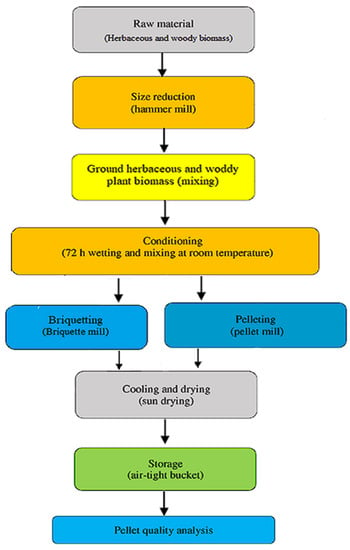
Figure 1.
The flow diagram for pellet production.
Chopping and milling. The first operation of the biomass processing technological process is to chop the harvested, dried biomass. In this study, the biomass of the invasive plants—giant knotweed and Sosnowsky’s hogweed—was first dried and then chopped and milled using a drum chopper of Maral 125 forage and a Retsch SM 200 mill. The biomass was milled to pieces no larger than 2 mm in diameter because sieves with a mesh diameter of 2 mm were used.
The fractional composition of milled biomass was determined using sieve layers of differing hole diameters. For this experiment, Retsch AS 200 sieves and a sieve shaker were chosen. The sieve shaker consists of sieves with five hole diameters from top to bottom: 2 mm, 1 mm, 0.63 mm, 0.5 mm, 0.25 mm, and 0 mm. A mass of 100 g is sieved; after each sieve, the mass remaining on the sieve is weighed, and the tests are repeated three times.
Pellet production. The chopped and milled raw material was pelletized with a low-power (7.5 kW) biomass granulator ZLSP200B (Poland) with a horizontal matrix, in which the diameter of the matrix holes was 6 mm. The granulator capacity was 100–120 kg h−1.
Before the milled raw material was placed in the granulator, the material was mixed to achieve homogeneity and was moistened with a small amount of water (0.5–1%).
Pelleting process variables were determined according to the requirements of the ZLSP200B manufacturer’s instructions. The quantities of prepared material were up to 5 kg. The prepared mill used 12–15% moisture content for pellet production. The compression ratio refers to the ratio of the effective length of the die holes to the die hole diameter. While adjusting the position of the roller and the die that we used according to the manufacturers’ recommendations, the ratio was controlled visually but was not more than 0.3 mm. The temperature within the pellet machine was not controlled. The length of the pellets was adjusted by controlling the cutting knife mechanism of the pellet machine, which was adjusted for 25–30 mm. After the pellets were formed, they were cooled and dried in the natural room conditions.
Briquette production. Briquettes were produced from the same biomass as the pellets. The briquettes were produced in the laboratory of Vytautas Magnus University, Agriculture Academy. A prepared mill was used with 12–15% moisture content for briquette production, similar to the conditions for pellet production. In addition, additional samples were created by mixing pine wood biomass with Sosnowsky’s hogweed and pine wood biomass with giant knotweed in equal parts (1:1). The briquetting process variables were determined according to the manufacturer’s instructions. The biomass briquetting process is simpler compared to the granulation process. A screw briquetting machine with motor power of 7.5 kW was used for the production of briquettes. The chopped and milled biomass entered the press, where it was compressed. The manufactured briquette was then pushed out of the press and cut into cylinders of the required length (150–200 mm). No binders were used in the briquetting process. During briquetting, the biomass was heated to 70–90 °C, as in the granulation process. The manufactured briquettes were cooled.
Moisture content. To determine the moisture content of the pellets, three samples of each plant’s biomass were taken and placed in cruets. These cruets were weighed and placed in a drying cabinet. The samples were kept in the drying cabinet for 24 h at a constant temperature of 105 °C. After drying, the dried samples and empty cruets were weighed. The moisture content of all samples was calculated including the averages with standard deviations.
Pellet density. To determine the pellet density, 10 produced pellets were chosen at random and weighed. The diameter and length of each pellet were measured to determine the volume of each pellet. With these measurements, each pellet’s density was determined.
Compression resistance of pellets. Five produced pellets from each different plant were again chosen at random and tested in a laboratory. An INSTRON 5965 compression testing tool with a 5-kN capacity (Figure 2) was used for this experiment. The cylindrical pellets were horizontally placed between two anvils, and a compressive force was applied to the side of the pellet. The tester (head) was run at a compression rate of 20 mm·min−1 and was stopped after the pellet had fractured or broken. Each pellet was tested until it reached a critical point. The data were tracked using the Bluehill tools’ software, and the resistance to compression of each pellet was determined. The experiment results were recorded every 0.1 s.
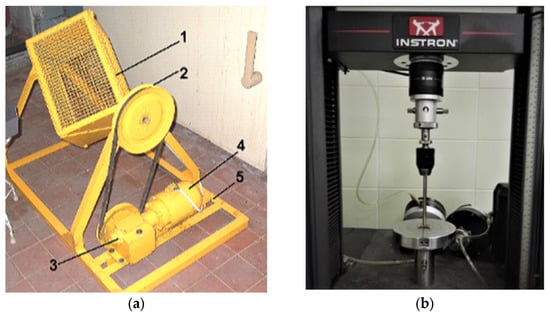
Figure 2.
(a) Briquette fragility testing stand: 1—mesh-covered box for briquettes; 2—belt drive; 3—drive; 4—electric motor; 5—frame (left); Instron 5965 (right); (b) Instron 5965.
Briquette strength. The brittleness of the manufactured briquettes was also determined using a test bench (Figure 2). Weighed test briquettes were placed in a rectangular box, the electric motor was switched on, a frequency of 13 revolutions per minute was used, and the bench was kept on for 3 min. A container was placed under the stand, where the crushed mass was collected. At the end of the 3-min test time, the fallen mass was weighed, the mass difference was calculated, and the lost mass was determined as a percentage. The test was repeated five times for each type of briquette. This method was developed by Jasinskas and other scientists, and it was not standardized and was very similar to the method for the determination of pellet strength []. The authors of this paper did not make any adjustments to this methodology, as it is adequate for determining the strength of produced briquettes from invasive herbaceous plant biomass with no binding additives.
Statistical analysis. MS Office Excel software was used for the statistical processing of the results. During data processing using the appropriate number of repetitions, average values and mean values with the 95% confidence intervals of the mean were calculated. The least significant difference LSD05 was calculated using the t-test at a probability of p ≤ 0.05 [].
Elemental composition, ash content, and caloric value. The experiments that determined the elemental composition, ash content, and caloric value were performed at the Lithuanian Institute of Energy, Thermal Equipment Testing and Research Laboratory. The methodology of these tests is valid in Lithuania and other European countries. For ash content, we used method Nr. 8B/5–LST EN 14775:2010; for elemental composition, we used methods Nr. 8B/3–LST EN 15104:2010; and for calorific value, we used method Nr. 8B/2–LST EN 14918:2010 [].
Emissions. The tests were carried out at the Lithuanian Institute of Energy, Thermal Equipment Testing and Research Laboratory, in accordance with the requirements of the LST EN 15104:2010 standard [] for burning produced pellets. The amounts of total carbon, hydrogen, nitrogen, sulfur, and oxygen formed during combustion were measured by the following combustion product analyzer: data tester 400CEM and analyzer VE7 [].
Ash fusibility. The tests were carried out at the Lithuanian Energy Institute, Thermal Equipment Testing and Research Laboratory, which uses the standards and methodology according to the Lithuanian standard for determining ash melting parameters. The parameters evaluated were the following.
Initial Deformation Temperature (DT): It is the temperature at which the ash begins to soften and deform under the influence of heat. The DT indicates the starting point of ash fusion or melting.
Softening Temperature (ST): It is the temperature range within which the ash undergoes significant softening and deformation. The ST helps to identify the range of temperatures at which the ash becomes sticky or forms a molten slag.
Hemispherical Temperature (HT): Also known as the fluid temperature, it is the temperature at which the molten ash forms a hemispherical shape or a fully developed molten slag ball. The HT represents the point at which the ash reaches maximum meltability.
Flow Temperature (FT): It is the temperature at which the molten ash starts flowing under its weight or gravity. The FT provides an indication of the ash’s ability to form a fluid slag that can be drained or removed from the combustion system.
3. Results and Discussion
3.1. Qualitative Parameters of Produced Pellets
The pellets and briquettes produced from coarse stem invasive herbaceous plants were of solid form and did not fall apart upon cooling (Figure 3).
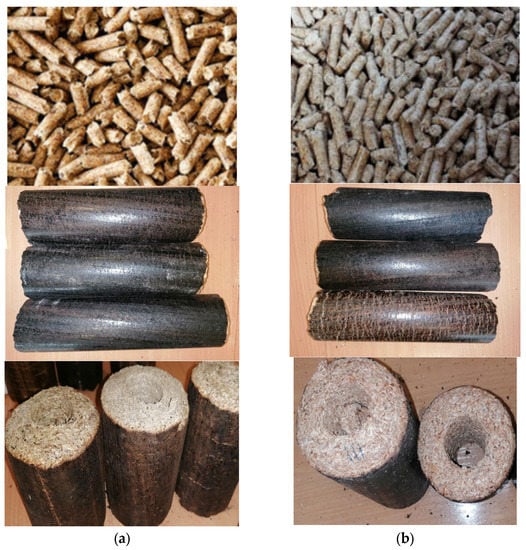
Figure 3.
Produced pellet and briquette samples: (a) giant knotweed; (b) Sosnowsky’s hogweed.
The fractional composition of milled biomass from giant knotweed, Sosnowsky’s hogweed, and pine was determined (Figure 4).
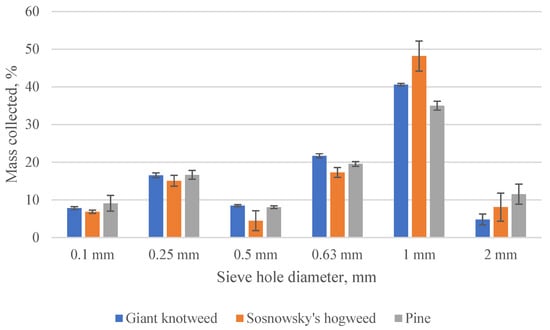
Figure 4.
Fractional composition of milled biomass.
The experiment showed that there were no pieces smaller than 0.1 mm in diameter. It is also notable that, during the milling process, the particle sizes seemed to follow a similar pattern because the biomass was thoroughly dried and did not clump. These results showed that the milling process can be the same for these types of herbaceous plants without modification.
A prepared mill was used with 12–15% moisture content for pellet and briquette production. The pellets were produced, and their physical properties in Table 1 were determined. The pellet diameter corresponded to the diameter of the granulator matrix, which was 6 mm, and the greater diameter of the pellets was attributed to the heat expansion of the material.

Table 1.
Physical properties of pellets.
From Table 1 we can see that the parameters of pellets from invasive herbaceous plants do not differ much from those from woody pine biomass. The content of the investigated pellets’ moisture was 4.96% for Sosnowsky’s hogweed, 7.95% for giant knotweed, and 6.9% for pine pellets. There was no significant difference between Sosnowsky’s hogweed and pine species, which were used for controls, in produced pellet density. Additionally, there was no significant difference between pine and giant knotweed pellets. The giant knotweed pellet density was the highest and reached 1227.47 ± 39.82 kg m−3.
The density of the pellets of herbaceous plants adjusted for variance was roughly similar to that of pine pellets. Researchers Bidhan Nath and others studied densified fuel quality parameters of wheat straw pellets, and their determined density of the pellets was similar—1189 kg m−3 []. They determined that the only difference was in the length of the pellets.
The pellets that were produced from pine biomass were longer, and their mass was larger, but the density was roughly equivalent to that of the herbaceous invasive plant pellets. This outcome indicates that the pellets produced from herbaceous invasive plants, such as Sosnowsky’s hogweed and giant knotweed, are viable for solid biofuel production. The same analysis was performed for briquettes (Table 2).

Table 2.
Physical properties of briquettes.
Scientists Granado and others produced briquettes from cassava rhizome, sugarcane bagasse, and sugarcane straw. The produced briquette density ranged from 1240 to 1300 kg m−3, which is greater than that of herbaceous plant briquettes [].
After measuring the geometric parameters of the briquettes, the diameters of the cylindrical briquettes were determined: coniferous wood—80.38 ± 0.62 mm, Sosnowsky’s hogweed and wood mixture—80.20 ± 0.25 mm; Sosnowsky’s hogweed—80.11 ± 0.32 mm; giant knotweed and wood mixture—80.07 ± 0.35 mm; and giant knotweed—80.48 ± 0.73 mm. According to these average means, it can be said that the briquettes were formed correctly and were of a similar diameter.
The measured lengths differed significantly because the briquettes did not break at the same length. Among the herbaceous plants, the densities of Sosnowsky’s hogweed and its mixture with wood, respectively, 867.31 ± 116.50 kg m−3 and 711.20 ± 106.70 kg m−3, were better than those of giant knotweed and its mixture with wood, respectively—615.60 ± 96.61 kg m−3 and 654.50 ± 19.35 kg m−3. The pine wood briquettes’ density was 765.29 ± 128.76 kg m−3. There was no significant difference between the pine wood and Sosnowsky’s hogweed mixture with wood briquettes. Additionally, there was no significant difference between giant knotweed and its mixture with wood briquettes.
The density of wood briquettes was slightly greater than the densities of other investigated plants, and as a result, the density traditionally increased when the wood mill was mixed with the mill of other plants. However, these non-significant changes in density are highly dependent on various technological and other parameters of the briquetting process.
Similar results were obtained by researchers Jaya S. Tumuluru and Eric Fillerup, who produced biofuel briquettes from a mixture of herbaceous and woody biomass and measured the unit density of produced briquettes as greater than 750 kg m−3 [].
The properties of pellets are significantly improved compared to unprocessed biofuel. The main advantage is the increased density, as a result of which better combustion efficiency and adjustment of its modes are achieved. Additionally, harmful emissions released during combustion were lower []. These parameters meet the requirements for the use of biofuel.
The pellets and briquettes produced from invasive herbaceous plants, Sosnowsky’s hogweed and giant knotweed, were subjected to a test in which their strength was determined when the maximum critical loads were presented (Figure 5 and Figure 6). This test ensured that the pellets were not destroyed during the transportation and utilization processes.
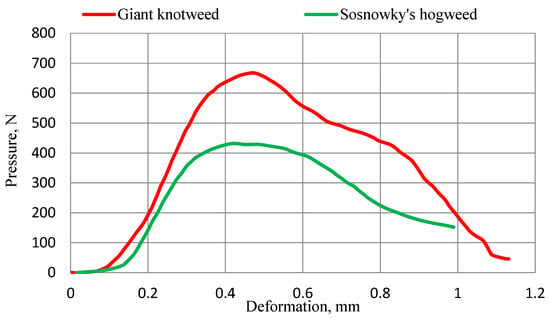
Figure 5.
Compressive resistance of pellets.
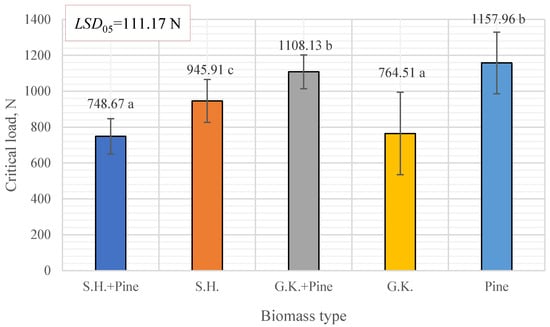
Figure 6.
Compressive resistance of pellets. (Matching letters indicate no significant difference between different pellet types. Error bars represent the 95% confidence interval of the mean. The t-test was used for statistical analysis).
The strength test curves of giant knotweed and Sosnowsky’s hogweed pellets are shown in Figure 5. From five samples, an average inherent curve was chosen on purpose to show the character of the force variation in the strength test. Analyzing the deformation curves, we observed that the maximum crushing force in the horizontal direction was 667.36 N in the giant knotweed pellets series to 0.42 mm until the pellets completely disintegrated. Sosnowsky’s hogweed pellets reached a 431.53-N maximum crushing force to 0.47 mm.
The experimental results presented in Figure 6 show that the average strength of the pine pellets, with a semi-static stability of 1157.96 ± 171.56 N in the horizontal direction, was found to be the most mechanically stable. This pellet type was used as a control. Second in the strength test was giant knotweed and pine mixture (G.K.+Pine) pellet type. The pellets reached 1108.13 ± 93.93 N of compressive resistance. Next in order were Sosnowsky’s hogweed (S.H.) with 945.91 ± 119.30 N and giant knotweed (G.K.) with 764.51 ± 230.30 N, and the weakest were the Sosnowsky’s hogweed and pine mixture (S.H.+Pine) pellets, with 748.67 ± 98.45 N. There was no significant difference between Sosnowsky’s hogweed and pine mixture (S.H.+Pine) and giant knotweed (G.K.)-type pellets. There was also no significant difference between giant knotweed and pine mixture (G.K.+Pine) and pine pellets, which were used for controls.
The resistance to compression test showed that the pellets and briquettes produced from the invasive herbaceous plants Sosnowsky’s hogweed and giant knotweed adhered to the quality standard required by the European Union. The compressive resistance of briquettes was greater than that of the pellets, although it is noteworthy that a mixture of Sosnowsky’s hogweed and pine biomass produced briquettes of inconsistent strength.
According to researchers Kaliyan Nalladurai and R. Vance Morey, the quality of the densification process depends on various factors, such as moisture content, feed intake speed, particulate size, and quality of biomass, so further research is required to determine the best variables while producing biofuel pellets []. The pellets and briquettes produced will not degrade during packaging or transport.
The Latvian scientists Kakitis and others also studied the possibility of using fibrous hemp Bialobrzeskie, Futura 75, and Santhica 27 for the production of pressed biofuel. They studied the mechanical properties of the briquettes and their strength, and they determined the critical pressure of the briquettes, which varied from 101.28 to 122.37 N [].
The produced briquettes were also subjected to a fragility test to determine their structural integrity, and the results are shown in Figure 7.

Figure 7.
Briquette fragility test results. (Matching letters indicate no significant difference between different briquette types. Error bars represent the 95% confidence interval of the mean. The t-test was used for statistical analysis).
After carrying out briquette fragility tests, it was found that the most vulnerable to mechanical forces were the briquettes of Sosnowsky’s hogweed (S.H.) and giant knotweed (G.K.); after the test, they lost 1.26% and 1.03% of their mass, respectively. In this study, no additional binders were used during briquette production. There was no significant difference between the Sosnowsky’s hogweed and pine mixture (S.H.+Pine) and pine pellets, which were used for controls. There was also no significant difference between the giant knotweed and Pine mixture (G.K.+Pine) and giant knotweed (G.K.)-type pellets.
Nikiforov and other produced briquettes from sunflower husks and coal dust mixtures and analyzed their fragility. Briquettes made from sunflower husks and coal dust lost mass from 25 to 38%, which is significantly greater than that of Sosnowsky’s hogweed and giant knotweed [].
3.2. Dependence of the Compressive Strength of Invasive Plant Pellets on Moisture Content
Studies of the physical–mechanical properties of herbaceous, large-stemmed, invasive plant pellets, such as compressive strength, were performed using INSTRON 5965 equipment. The resistance to crushing of large-stemmed plant biofuel pellets produced from Sosnowsky‘s hogweed and giant knotweed was investigated, and its dependence on humidity was determined (Figure 8). Moisture values varied from 5% to 15%.
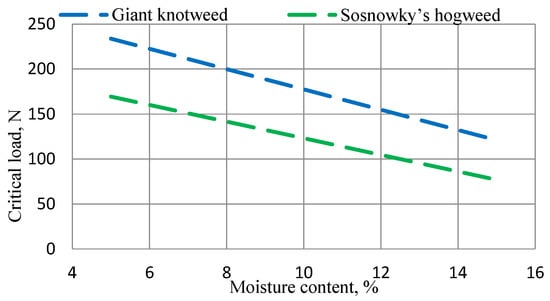
Figure 8.
Dependence of the compressive strength of large-stemmed invasive plant pellets on moisture content.
After conducting these studies, we found that the compressive strength of investigated biofuel pellets varied depending on the plant species. From the presented graphs, it can be seen that the compressive strength decreased linearly with increasing humidity. The values of the coefficients of the linear equations were determined using experimental research data (Table 3).

Table 3.
The values of the coefficients (a and b) of the equation and the values of the correlation coefficient (R2).
The graphs were obtained using a linear regression equation []. This is example (1) of an equation:
where: F—mechanical compressive strength of pellets, N;
w—moisture content of pellets, %; and
a, b—coefficients of equation.
The dependences of the compressive strength of invasive plant pellets on moisture content are presented in Figure 8.
The compressive strength of biofuel pellets of large-stemmed invasive plants shows the strength of the pellet depending on the water content in it. Using linear Equation (1), the dynamics of the change in the compressive strength of the pellets depending on the moisture content were calculated. It was found that the pellets of giant knotweed were significantly stronger and more resistant to compression, and the critical compressive strength of them was higher than the loading force of Sosnowsky’s hogweed pellets. The critical load force of giant knotweed pellets varied from 233.7 N to 121.0 N (with increasing moisture content from 5% to 15%), and the critical load force of Sosnowsky‘s hogweed pellets varied from 169.3 N to 76.8 N. The characteristics of the variation in studied large-stemmed invasive plant pellets were similar, indicating that humidity had a similar effect on the strength of both plant pellets.
3.3. Determination of Harmful Emissions
Research on the burning of Sosnowsky’s hogweed and giant knotweed pellets was carried out at the Lithuanian Energy Institute, in the thermal equipment research and testing laboratory. Sosnowsky’s hogweed and giant knotweed pressed biofuel pellets and briquettes were completely burned, and their emissions were measured, which are presented in Table 4 and Figure 9 and Figure 10. Pellets made from pine wood were also burned to compare the differences in emissions.

Table 4.
Emissions of Sosnowsky’s hogweed, giant knotweed, and pine biofuel.

Figure 9.
CO concentrations during combustion of: (a) Sosnowsky’s hogweed; (b) giant knotweed; (c) pine wood.
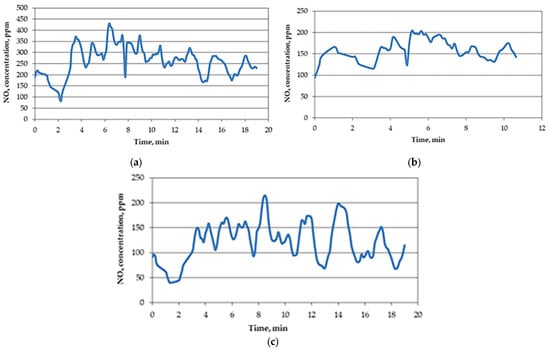
Figure 10.
NOx concentrations during the combustion of: (a) Sosnowsky’s hogweed; (b) giant knotweed; (c) pine wood.
The burning process went to completion, although as we can see in Table 4, Sosnowsky’s hogweed produced 1778.44 ppm of CO gas, and the reason for this outcome was uneven burning of the pellets. Giant knotweed also fluctuated in burning intensity, which is why it produced 915.3 ppm of CO gas. The NOx values were 121.31 ppm for Sosnowsky’s hogweed and 67.4 ppm for giant knotweed. According to the LAND 43-2013 Lithuanian standard for biofuel burning, these parameters were within acceptable ranges.
Comparing these values to those of researchers Jan Malatak and others, who also burned briquettes produced from herbaceous plant biomass, we see that their values of NOx varied from 59.16 ppm to 199.38 ppm, and their CO values ranged from 1547.88 ppm to 2339.42 ppm [].
The biofuel made from invasive herbaceous plants produces more carbon monoxide than biofuel from pine wood, but the parameters are within the European standards. The usage of these plants for biofuel offsets the energy cost of exterminating them from the ecosystem. From the determined parameters, we can see that giant knotweed is more suitable for solid biofuel production. Although the biomass from Sosnowsky’s hogweed produces more volatile end products, it can be used as intermediate material for the production of solid biofuel.
The chemical, elemental composition of Sosnowsky’s hogweed and giant knotweed has been analyzed and evaluated for the production of solid biofuel (Table 5). The solid biofuel produced from invasive herbaceous plants was inferior to biomass produced from woody pine, but it complied with the European standards mentioned above. The ash content of herbaceous plants is higher than that of wood biomass, but the parameters of ash content are equivalent.

Table 5.
Elemental properties of Sosnowsky’s hogweed, giant knotweed, and pine.
Scientists in many countries, considering the specific climatic conditions of those countries, are also searching for new types of plants suitable for biofuel, their processing, and their use for energy conversion. The Latvian scientists Adamovics and others determined that the calorific value of fiber hemp grown under suitable conditions was 17.76–18.98 MJ kg−1, and the ash content was 1.5–2.7% [].
Comparing the values with K. Paramonova’s [] research, the lower calorific value of Sosnowsky’s hogweed seems to be similar—16.5 MJ kg−1—to that which was calculated in this paper at 15.89 ± 1004 MJ kg−1. These parameters show that the biomass from giant knotweed and Sosnowsky’s hogweed are acceptable for solid biofuel production.
Straw pellets have a CO content of 6.4–5.0 g kg−1, while wood pellets have a CO con-centration of 1.3–1.9 g kg−1, per the research findings of other teams. The NOx concentrations were correspondingly 3.608 g kg−1 and 1.402 g kg−1 [].
Other researchers have calculated NOx content of 225 mg MJ−1, and the CO concentration in peat was 140 mg MJ−1 [].
Finnish researchers studied biofuel made from a blend of wood and reed canary grass in proportions of 78% and 22%. CO levels were 9.631 mg MJ−1, and NOx levels were 21,217 mg MJ−1 [].
Reed canary grass, giant knotweed, and elephant grass quantities of CO, NOx, and HCl were estimated by Czech researchers. Reed canary grass that had been burned was found to release 746 mg m−3 of CO, 248 mg m−3 of NOx, and 198 mg m−3 of HCl. Elephant grass produced 543, 167, and 133 mg m−3 of these emissions, respectively, while giant knotweed produced 249, 300, and 238 mg m−3 [].
Other scientists have examined giant knotweed briquettes. The concentrations of CO, NOx, and HCl were measured. Three variables with high concentrations were CO (3088.6 mg m−3), NOx (194.95 mg m−3), and HCl (157.69 mg m−3). Burning wood briquettes yielded similar findings, including CO levels of 2313.6%, NOx levels of 48.5%, and HCl levels of 39.03 mg m−3. As can be seen, giant knotweed is more hazardous than wood biofuel [].
The ash from burning produced biofuel has been analyzed to determine whether its melting temperature will not detrimentally affect the boiler. Results are provided in Table 6, where it is evident that ash properties produced from these herbaceous plants are comparable to those of pine wood.

Table 6.
Ash fusibility parameters.
In Table 6 we can see that the lowest softening temperature (ST) was of pine biomass—849 ± 8.60—and the highest was of Sosnowsky’s hogweed—1316 ± 28.28. The ash deformation temperature (DT) was lowest of Sosnowsky’s hogweed—1435 ± 9.90—and the highest of was of pine—1497 ± 10.76. The hemispherical temperature (HT) and flow temperature (FT) both had the same pattern, with Sosnowsky’s hogweed being the lowest and pine biomass being the highest. These parameters showed that the melting and softening points of invasive herbaceous biomass do not detrimentally affect the boiler function since they are comparable to those of the woody biomass used in standard boilers.
4. Conclusions
The presented research results showed that the biomass produced from the invasive herbaceous plants Sosnowsky’s hogweed and giant knotweed is suitable for the production of solid renewable biofuel. The caloric values of Sosnowsky’s hogweed, giant knotweed, and pine varied at 15.86 ± 1.04 MJ kg−1, 17.73 ± 0.33 MJ kg−1, and 18.63 ± 0.33 MJ kg−1, respectively. The pellets’ unit density varied only slightly among the different biomasses with the lowest being of Sosnowsky’s hogweed—1145.60 ± 37.50 kg m−3—and the highest being of giant knotweed—1227.47 ± 39.82 kg m−3. Briquette density on average was lower than that of pellets. Sosnowsky’s hogweed pellets were less resistant to compression than giant knotweed, and among briquettes, the average compressive resistance was higher than that of the pellets. After determination of harmful emissions, it was noted that both herbaceous invasive plants produced much more harmful byproducts than pine: Sosnowsky’s hogweed produced 1778.44 ppm of CO, giant knotweed produced 915.3 ppm of CO, and pine produced 187.50 ppm of CO. The parameters and characteristics of these invasive herbaceous plants met all of the required specifications of European standards. It was also determined that Sosnowsky’s hogweed and giant knotweed are suitable additions to currently produced woody biomass pellets. It was further determined that ash content removal of invasive herbaceous plants was sometimes greater compared to that with woody biomass. As a result, the most important conclusion that can be drawn is that all of the investigated pressed biofuels met the most important quality requirements for pressed solid biofuel and can be used for burning in special boilers suitable for granular biofuel or briquettes.
Author Contributions
Conceptualization, G.G., A.J., R.M. and V.K.; methodology, G.G., A.J., E.B., V.K. and J.S.; validation, G.G. and A.J.; formal analysis, A.J., R.M. and J.S.; investigation, G.G., A.J., R.M. and V.K.; data curation, G.G., A.J., E.B. and V.K.; writing—original draft preparation, G.G., A.J. and R.M.; writing—review and editing, G.G., A.J., R.M., E.B., V.K. and J.S.; supervision, G.G. and A.J.; funding acquisition, G.G. and A.J. All authors have read and agreed to the published version of the manuscript.
Funding
This research received no external funding.
Institutional Review Board Statement
Not applicable.
Informed Consent Statement
Not applicable.
Data Availability Statement
Not applicable.
Conflicts of Interest
The authors declare no conflict of interest.
References
- Karthik, V.; Periyasamy, S.; Varalakshmi, V.; Mercy Nisha Pauline, J.; Suganya, R. Chapter 15—Biofuel: A prime eco-innovation for sustainability. In Environmental Sustainability of Biofuels; Elsevier: Amsterdam, The Netherlands, 2023; pp. 267–284. [Google Scholar]
- Vareas, V.; Kask, U.; Muiste, P.; Pihu, T.; Soosaar, S. Biofuel User Manual; Zara: Vilnius, Lithuania, 2007; 168p. (In Lithuanian) [Google Scholar]
- Le Roux, J. The Evolutionary Ecology of Invasive Species; Academic Press: London, UK, 2021; pp. 1–209. [Google Scholar]
- Halmova, D.; Feher, A. Possibilities of utilization of invasive plant phytomass for biofuel and heat production. Acta Reg. Environ. 2009, 6, 49–53. [Google Scholar]
- Mishyna, M.; Laman, N.; Prokhorov, V.; Fujii, Y. Angelicin as the principal allelochemical in Heracleum sosnowskyi fruit. Nat. Prod. Commun. 2015, 10, 767–770. [Google Scholar] [CrossRef] [PubMed]
- Jakubowicz, O.; Zaba, C.; Noawk, G.; Jarmuda, S.; Zaba, R.; Marcinkowski, J. Heracleum sosnowskyi Manden. Ann. Agric. Environ. Med. 2012, 19, 327–328. [Google Scholar] [PubMed]
- Kappes, H.; Lay, R.; Topp, W. Changes in Different Trophic Levels of Litter-dwelling Macrofauna Associated with Giant Knotweed Invasion. Ecosystems 2007, 10, 734–744. [Google Scholar] [CrossRef]
- Gammon, M.A. The Diversity, Growth, and Fitness of the Invasive Plants Fallopia japonica (Japanese knotweed) and Fallopia xbohemica in the United States (polygonaceae). Doctoral Thesis, University of Massachusetts, Boston, MA, USA, 2009; p. 3361078. [Google Scholar]
- EU DD CENT/TS15149-1; Solid Biofuels. Methods for the Determination of Particle Size Distribution. Oscillating Screen Method Using Sieve Apertures of 3.15 mm and above. ISO: Geneva, Switzerland, 2006.
- Žaltauskas, A.; Jasinskas, A.; Kryževičienė, A. Analysis of the Suitability Tall-Growing Plants for Cultivation and Use as a Fuel. In Proceedings of the International Conference ‘Perspectives of Sustainable Technological Processes in Agricultural Engineering’, Raudondvaris, Lithuania, 20–21 September 2001; pp. 155–160. (In Lithuanian). [Google Scholar]
- Papamatthaiakis, N.; Laine, A.; Haapala, A.; Ikonen, R.; Kuittinen, S.; Pappinen, A.; Kolström, M.; Mola-Yudegoa, B. New energy crop alternatives for Northern Europe: Yield, chemical and physical properties of Giant knotweed (Fallopia sachalinensis var. ‘Igniscum’) and Virginia mallow (Sida hermaphrodita). Fuel 2020, 304, 121349. [Google Scholar] [CrossRef]
- Jasinskas, A.; Kučinskas, V.; Arak, M.; Olt, J. Research of Physical-Mechanical Properties of Sawdust Fuel Briquettes with the Additives. In Proceedings of the Rural Development 2013—The Sixth International Scientific Conference, Akademija, Lithuania, 28–29 November 2013. [Google Scholar]
- Olsson, U.; Engstrand, U.; Rupšys, P. Statistical Methods Using SAS and MINITAB; Lithuanian University of Agriculture: Akademija, Lithuania, 2000. [Google Scholar]
- LST EN 14918:2010; Solid Biofuel. Determination of Heat Capacity. ISO: Geneva, Switzerland, 2010. (In Lithuanian)
- LST EN 15104:2010; Solid Biofuels—Determination of Total Content of Carbon, Hydrogen and Nitrogen—Instrumental Methods. ISO: Geneva, Switzerland, 2011.
- Sakalauskas, A.; Jasinskas, A.; Šarauskis, E.; Vaiciukevičius, E.; Kalinauskaitė, S.; Simonaitis, P. Use of Perennial Grasses and Non-Traditional Herbaceous Plants (Elephant Grass, Sida, Cup Plant, Reed Grasses) and Their Mixtures for Pressed Biofuel Production: Final Report of the Agriculture, Food and Fisheries R&D Project. 2014; 68. (In Lithuanian)
- Nath, B.; Chen, G.; Bowtell, L.; Mahmood, A.R. Assessment of densified fuel quality parameters: A case study for wheat straw pellet. J. Bioresour. Bioprod. 2023, 8, 45–58. [Google Scholar] [CrossRef]
- Granado, M.P.P.; Gadelha, T.M.A.; Rodrigues, D.S.; Antonio, G.C.; Conti, A.C. Effect of torrefaction on the properties of briquettes produced from agricultural waste. Bioresour. Technol. Rep. 2023, 21, 101340. [Google Scholar] [CrossRef]
- Tumuluru, S.J.; Fillerup, E. Briquetting characteristics of woody and herbaceous biomass blends: Impact on physical properties, chemical composition, and calorific value. Biofuel Bioprod. Biorefining 2020, 14, 1105–1124. [Google Scholar] [CrossRef]
- Djatkov, D.; Viskovic, M.; Golub, M.; Martinov, M. Corn cob pellets as a fuel in Serbia: Opportunities and constraints. In Proceedings of the 45th International Symposium on Agricultural Engineering, Actual Tasks on Agricultural Engineering, Opatija, Croatia, 21–24 February 2017; pp. 417–426. [Google Scholar]
- Kaliyan, N.; Morey, V.R. Factors affecting strength and durability of densified biomass products. Biomass Bioenergy 2009, 33, 337–359. [Google Scholar] [CrossRef]
- Kakitis, A.; Nulle, I.; Ancans, D. Mechanical properties of composite biomass briquettes. In Environmental Technology Resources, Proceedings of the 8th International Scientific and Practical Conference, Rezekne, Latvia, 20–22 June 2011; Rezekne Academy of Technologies: Rēzekne, Latvia, 2011; Volume 1, p. 175. [Google Scholar]
- Nikiforov, A.; Kinzhibekova, A.; Prikhodko, E.; Karmanov, A.; Nurkina, S. Analysis of the Characteristics of Bio-Coal Briquettes from Agricultural and Coal Industry Waste. Energies 2023, 16, 3527. [Google Scholar] [CrossRef]
- Kruopis, J. Mathematical Statistics; Publishing House of Science and Encyclopedias: Vilnius, Lithuania, 1993. (In Lithuanian) [Google Scholar]
- Malatak, J.; Velebil, J.; Bradna, J.; Gendek, A.; Tamelova, B. Evaluation of CO and NOX emissions in real-life operating conditions of herbaceous biomass briquettes combustion. Acta Technol. Agric. 2020, 23, 53–59. [Google Scholar]
- Platace, R.; Adamovics, A.; Gulbe, I. Evaluation of factors influencing calorific value of reed canary grass spring and autumn yield. Engineering for rural development. In Proceedings of the 12th International Scientific Conference: Engineering for rural development, Jelgava, Latvia, 23–24 May 2013; pp. 522–524. [Google Scholar]
- Paramonova, K.; Ivanova, T.; Malik, A. Exploring the potential of invasive plant Sosnowsky’s hogweed for densified biofuels production. Ştiinţa Agric. 2021, 2, 105–108. [Google Scholar]
- Krugly, E.; Mrtuzevičius, D.; Puida, E.; Buisinecičius, K.; Stasiulaitienė, I.; Radžiūnienė, I.; Minikauskas, A.; Kliučininkas, L. Characterization of gaseous- and particle-phase emissions from the combustion of biomass-residue-derived fuels in a small residential boiler. Energy Fuels 2014, 28, 5057–5066. [Google Scholar] [CrossRef]
- Sippula, O.; Lamberg, H.; Leskinen, J.; Tissari, K.; Jokiniemi, J. Emissions and ash behavior in a 500 kW pellet boiler operated with various blends of woody biomass and peat. Fuel 2017, 202, 144–153. [Google Scholar] [CrossRef]
- Kortelainen, M.; Jokiniemi, J.; Nuutinen, I.; Torvela, T.; Lamberg, H.; Karhunen, T.; Tissari, J.; Sippula, O. Ash behaviour and emission formation in a small-scale reciprocating grate combustion reactor operated with wood chips, reed canary grass and barley straw. Fuel 2015, 143, 80–88. [Google Scholar] [CrossRef]
- Hutla, P.; Jevič, P.; Mazancova, J.; Plištil, D. Emission from energy herbs combustion. Res. Agric. Eng. 2005, 51, 28–32. [Google Scholar] [CrossRef]
- Strašil, Z.; Kara, J. Study of knotweed (Reynoutria) as possible phytomass resource for energy and industrial utilization. Res. Agric. Eng. 2010, 56, 85–91. [Google Scholar] [CrossRef]
Disclaimer/Publisher’s Note: The statements, opinions and data contained in all publications are solely those of the individual author(s) and contributor(s) and not of MDPI and/or the editor(s). MDPI and/or the editor(s) disclaim responsibility for any injury to people or property resulting from any ideas, methods, instructions or products referred to in the content. |
© 2023 by the authors. Licensee MDPI, Basel, Switzerland. This article is an open access article distributed under the terms and conditions of the Creative Commons Attribution (CC BY) license (https://creativecommons.org/licenses/by/4.0/).